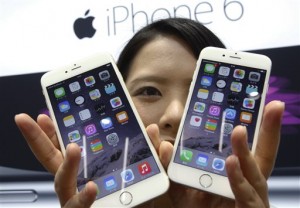WASHINGTON, United States — With its hot-selling large-screen iPhones released last year, Apple has roared back to the top of the pack with South Korea’s Samsung in the smartphone market.
Surveys released Thursday showed the popular iPhone 6 and 6 Plus helped Apple pull to a virtual tie in the fourth quarter with Samsung, which has been the leader for the past three years.
The research firm Strategy Analytics said Apple and Samsung shipped 74.5 million smartphones each in the last three months of 2014 for a market share of just under 20 percent.
A separate survey by IDC analysts said Samsung had a tiny edge over Apple with 75.1 million units sold.
Apple “beat everyone’s expectations,” said Ryan Reith at IDC.
Even more surprising is that Apple managed to increase the average selling price of its phones at a time when many consumers around the world are looking to low-cost handsets.
Another surprise was growth of iPhone sales in the US, “which is considered a saturated market,” according to Reith, and in China, where competition is intense.
“Sustaining this growth and higher (selling prices) a year from now could prove challenging, but right now there is no question that Apple is leading the way,” Reith said in a statement.
Samsung, which belatedly entered the market pioneered by Apple, had dethroned the US firm as the world’s top smartphone vendor in the third quarter of 2011.
The South Korean electronics giant then went on to replace Nokia as the global leader in overall mobile phone sales in the first quarter of 2012.
But Strategy Analytics said Samsung now faces “intense competition from Apple at the higher-end of the smartphone market, from Huawei in the middle-tiers and from Xiaomi and others at the entry-level.”
“Samsung may soon have to consider taking over rivals, such as Blackberry, in order to revitalize growth this year,” it added.
Even Apple has been surprised by its growth. Chief executive Tim Cook said during an earnings call this week that iPhone demand “has been staggering, shattering our high expectation.”
IDC’s Ramon Llamas told AFP that Apple is still seeing strong demand in early 2015 but that “it’s going to be difficult to maintain that breakneck pace.”
He added that “the fact that they attracted a number of Android users gives them growth prospects for 2015.”
Analysts said the smartphone market appears to be diverging with Apple dominating the high end and other manufacturers scrambling at the low end.
“There’s been so much skepticism for so many years about Apple’s ability to continue to make its unique business model work over the long term, and Apple continues to prove them wrong,” said Jan Dawson at Jackdaw Research in a blog post.
Rise in China
IDC said overall global smartphone sales hit a new record for the quarter and for the year: 375.2 million units shipped during the fourth quarter, a 28 percent increase from a year earlier, bringing the annual total to 1.3 billion, a gain of 27.6 percent.
Strategy Analytics said more than a billion Android-powered phones were sold last year, representing 81 percent of all handsets.
Chinese firms made headway in the smartphone market, led by Lenovo, which completed its acquisition of the Motorola brand last year.
IDC said Lenovo sold 24.7 million units for a 6.6 percent market share, edging out Huawei which delivered 23.5 million for a 6.2 percent share, according to IDC.
The rising Chinese star Xiaomi captured the number five spot, selling 16.6 million units with a 4.4 percent market share. Xiaomi’s growth from a year ago was 178 percent, IDC said.
But “Xiaomi’s grip on the number five spot is tenuous at best, with (South Korea’s) LG and (China’s) ZTE following close behind,” the IDC report said.
